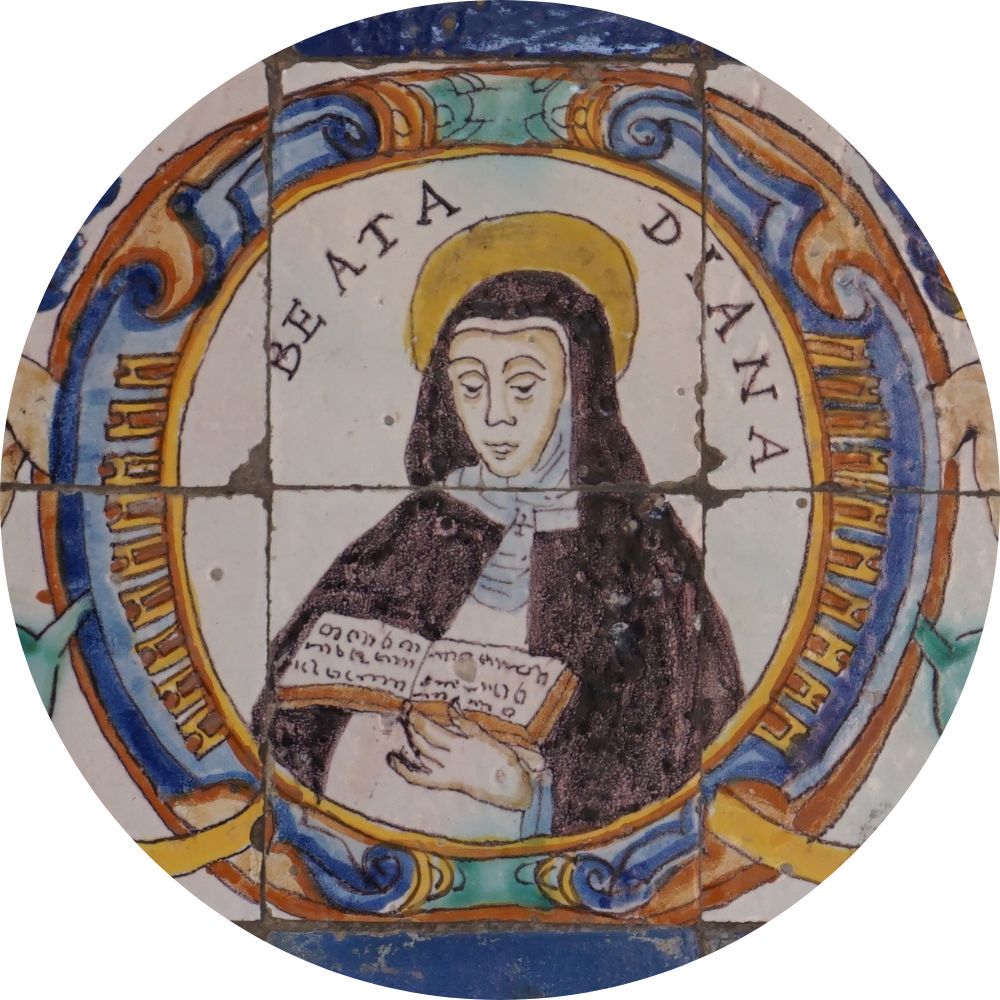Bl. Diana Andalo
Bl. Diana Andalo, virgin
(1201-1236)
Diana d'Andalò was born in 1201 in Bologna. She came from a noble and politically active family. Her father, Andrea Lovello, belonged to the Carbonesi coterie. The name of his family is derived from the diminutives of his name - Andreolo, Andalò. Andrea Lovello was to marry twice. Diana was a daughter from his first marriage. There is no information about her childhood, except that she was beautiful, cheerful and intelligent. In March 1219, as a devotee of Bl. Reginald of Olreanu helped him purchase the town of Vinge, where the monastery of St. Nicholas and the church of St. St. Dominic (now the Basilica of St. Dominic in Bologna) were erected. In August 1219, St. Dominic personally received her into a Dominican nunnery hoping that with the support of her wealthy family she would succeed in establishing a Dominican convent in Bologna. He encountered dual opposition. The Bishop of Bologna did not consent to the foundation. Diana's family was also against her joining to an order and commanded her to stay at home. They expressed their opposition again when, on July 22, 1221, Diana entered the Augustinian nunnery in Ronzano. This made Diana feel lost. St. Dominic wrote comforting letters to her. After Dominic's death, she once again fled to the nunnery in Ronzano. This time relatives did not dare to disturb her. She remained with the Augustinian nuns until June 1223.
Still in 1221, Bl. Jordan of Saxony, as the order's procurator general, decided to revive Dominic's project to establish a Dominican nunnery in Bologna. He managed to convince Diana's family that the only way she could stay close to her family was to just establish a convent. In 1222, Diana, with the help of her family and Jordan, founded, on a plot of land belonging to his father in Bologna, the convent of St. Agnes. The first group of nuns was received on June 29, the Solemnity of Saints Peter and Paul, during which Jordan personally clothed them. Diana spent the rest of her life in the convent of which she became the superior. She maintained correspondence with Jordan of Saxony, and many of their letters still exist. She died on June 10, 1236, in the reputation of sainthood. She was only 35 years old.
Her monastic life was associated with two other women, Agnes and Cecilia, with whom she lived in the same monastery. Later, all three together received worship. After Cecilia's death in 1290, their bones were placed in one grave. The cult was approved by Pope Leo XIII on August 8, 1888, thereby declaring them blessed. Liturgical memory of Bl. Diana falls on June 9.
In iconography, Bl. Diana is depicted as a Dominican woman holding a lily - a symbol of purity. The attribute is also a reminder of the tradition, which says that even in 1219, before she entered the convent, she took a vow of chastity to St. Dominic. Sometimes she is also shown with a model of a monastery - as the founder of the convent of St. Agnes in Bologna.
Bibliography:
- Melloni G. B., Atti e Memorie degli uomini illustri in santità nati o morti in Bologna, vol. I, Bologna 1773, pp. 194-255, 363-389.
- Les bienheureuses Diane, Cécile et Amée. Filles spirituelles de Saint Dominique, Lyon 1883.
- Confirmationis cultus immemorabilis simul ac concessionis et approbationis commemorationis servarum Dei Caeciliae et Amatae auae beatae nuncupantur ad iungendae Officio, Missae et Elogio in Martyrologio in honorem b. Dianae de Andalo, Roma 1890.
- Beati Iordani de Saxonia Epistulae, a cura di A. Walz, in Monumenta Ord. Fr. Praed. histarica, XXIII(1951), con esame critico delle ediz. precedenti; Iordani de Saxonia Opera quae extant, a cura di J. J. Berthier, Freiburg 1891.
- Cormier H. M., La b. Diane d'Andalo et les bb. Cécile et Aimée, Roma 1892 (Italian translation: Vita delle beate Diana d'Andalò, Cecilia ed Amata, fondatrici del Monastero delle domenicane di S. Agnese in Bologna, tradotta per cura E. Mauri, Roma 1892).
- Malvezzi N., Diana d'Andalò, Bologna 1894.
- Siedlecki J., Bogosławione Dianna, Cecylia i Amanda, duchowne córki świętego Dominika, Kraków 1893.
- Georges N., Blessed Diana and Blessed Jordan of the Order of Preachers, Somerset 1933.
- Vann G., To Heaven with Diana! A study of Jordan of Saxony and Diana d’Andalò with a translation of the Letters of Jordan, New York-Lincoln-Shanghai 1960 (later edition 2006).
- Jourdain de Saxe, Lettres a la B. Diane d’Andalo (1222-1236), trad. nouv. avec notes historiques et annexes par Marguerite Aron, Lille-Bruges 1924 (La Vie Spirituelle, 4) (Polish edition: Jordan z Saksonii, Najdroższej Dianie… Listy do błogosławionej Diany Andalo, apoftegmaty, przełożył, wstępem i przypisami opatrzył P. Krupa, Poznań 1998, 20172).
- Cambria M. G., Diana degli Andlo. La figlia prediletta di S. Domenico, Bologna 1972.

